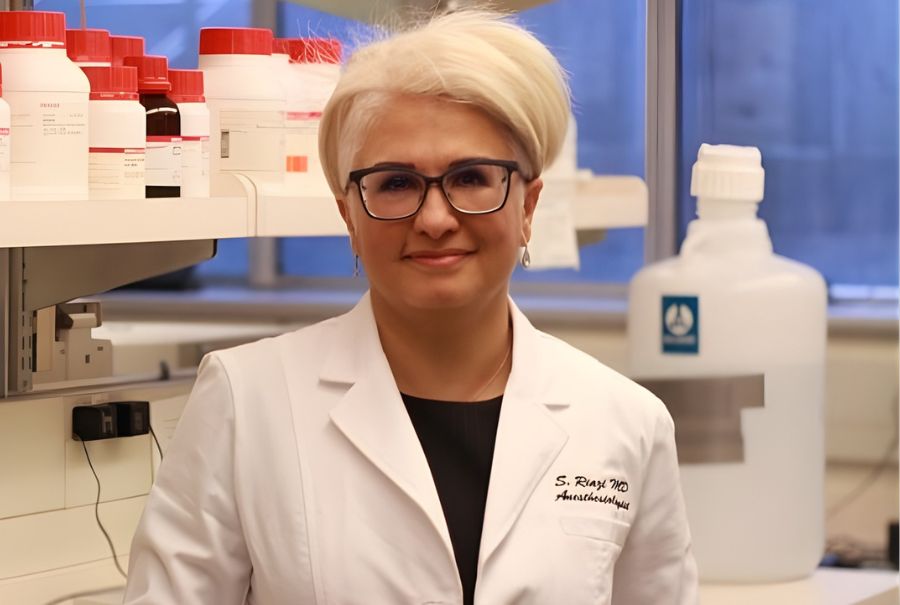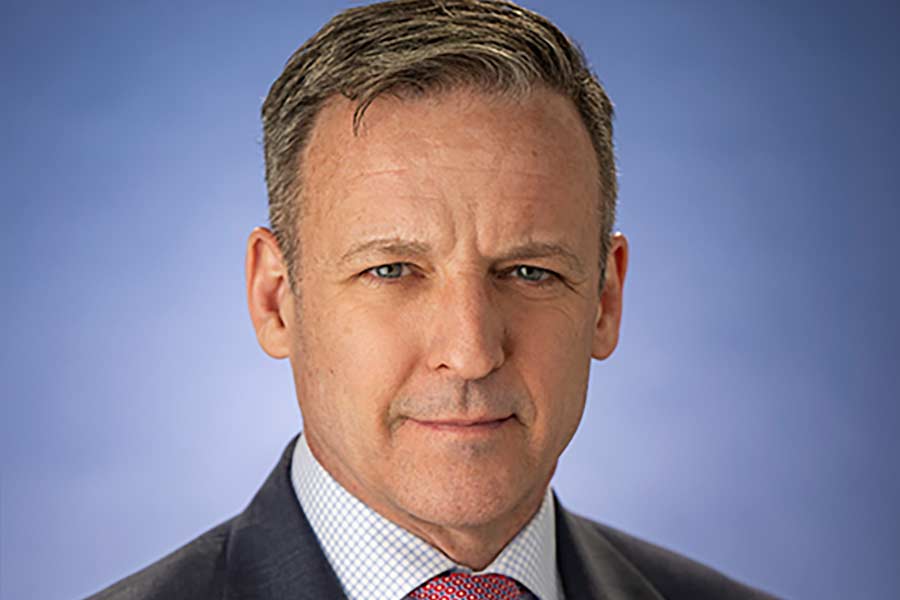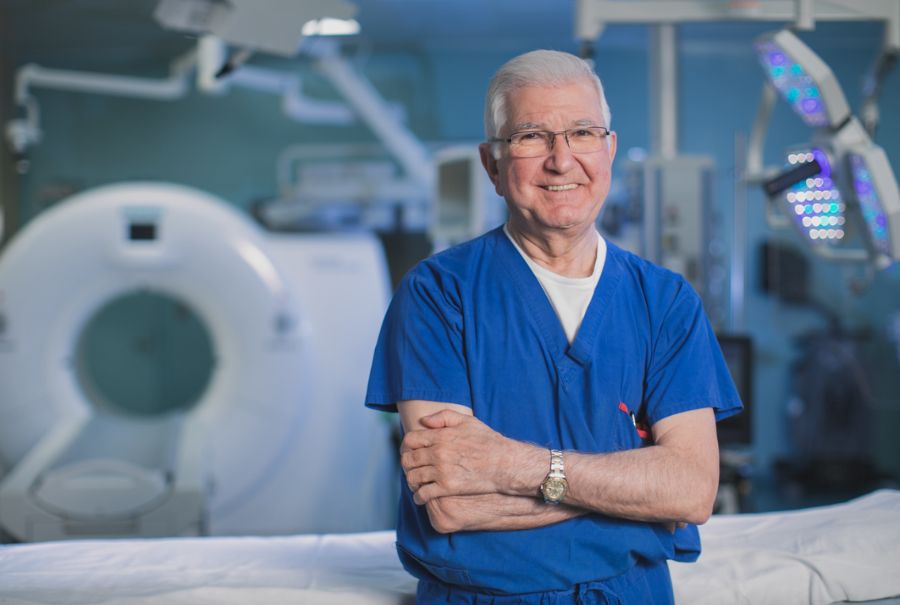Dr. Ryan Luther and the General Internal Medicine team critical to UHN’s fight against COVID-19.
Contrary to popular belief, the place where most COVID-19 patients are treated is not the Emergency Department (ED) or Intensive Care Unit (ICU). The site where this happens is the General Internal Medicine (GIM) unit, where care is provided to about 70 per cent of University Health Network’s (UHN) COVID-19 patients. It’s also Dr. Ryan Luther’s second home.
It’s been almost a decade since Dr. Luther first became acquainted with UHN. He started as a medical student before completing his junior residency, followed by his chief residency. About a year ago, he was hired as GIM staff physician at Toronto General Hospital (TGH). GIM physicians are experts at diagnosing diseases and managing acute medical problems. Their scope of care is comprehensive.
Dr. Luther’s anniversary as UHN faculty member will forever coincide with the onset of the COVID-19 crisis, an apropos connection given his title of TGH COVID Service Chief and Education Lead. He wasn’t thrust into this position instantaneously, however. Like so many GIM physicians, he spent the early pandemic days helping out, trying to navigate an uncharted course without a compass. It was a scary time, he recalls, but he felt a calling to assume a bigger role.
“I’m the most junior member of the division. My wife and I don’t yet have children or older adults living with us, so from an exposure perspective, I felt I was probably the lowest-risk person to do the clinical care,” he says. “As a new staff member, it was a learning opportunity. We knew nothing about this disease. Everyone was terrified. We knew how to provide comprehensive inpatient medical care, but when it came to managing COVID, we had no targeted treatments. All we could do was provide supportive care and hope our patients would get better.”
Although he says his risk was lower than that of his colleagues, it wasn’t nonexistent. Dr. Luther lives with his wife, a palliative care doctor at Toronto Western Hospital, in a two-bedroom apartment. In the early weeks of the pandemic, they were vigilant about changing scrubs, disinfecting items and showering as soon as they returned home from work. They fashioned a makeshift line using tape that they wouldn’t cross before everything had been sanitized. They slept separately – she in their bedroom, he on an air mattress in their office. They used different bathrooms. They split up their dishes.
“We were so scared of infecting each other. It wasn’t easy,” he remembers. “I still get worried when I come home – less than I did before, but I never want to have to carry the burden of having infected my wife.”
Dr. Luther says he and his partner had many discussions about his job and whether he should be placing himself in the path of this new, insidious enemy. As he puts it, his “personal sense of duty” won out.
How COVID-19 redefined a unit
Prior to COVID-19, Dr. Luther was a clinician-teacher on the GIM wards. He spent his time showing the ropes to residents and medical students. Together, they cared for patients.
The work was a far cry from using FaceTime or Zoom to connect a patient with their family for final farewell messages. This is a COVID-19 exercise he has had to weave into his role and a task he must be prepared to face whenever he dons his scrubs.
Dr. Luther manages the medical team on the GIM unit. His daily duties begin at 7 a.m. when he arrives on the floor to review overnight issues and patient vitals with the nursing staff. From 8 a.m. to noon, he does his rounds, evaluating each patient. Then, with the nurse practitioner, he contacts every family with a patient under his care. They provide updates and support, a function of his job he says is extremely rewarding and impactful.
Educating other providers to care for COVID-19 patients during a rapidly evolving pandemic is critically important. To this end, Dr. Luther and his GIM colleagues have overseen the training of their coworkers who volunteered to care for COVID-19 patients. The educational curriculum includes a handbook and training videos that review COVID-19-specific ward procedures.
In April and May 2021, Dr. Luther organized and led a “COVID-19 boot camp,” consisting of three virtual grand rounds for the entire Department of Medicine, which covered the most up-to-date management of, and treatments for, patients with the virus. The sessions armed healthcare workers – those who have been redeployed and those awaiting the call – with the skills they’ll need to draw on if and when they’re asked to care for patients on the COVID-19 unit.
These sessions and materials are complemented by an intensive practical experience where colleagues from other divisions attend patient care rounds with GIM physicians on the COVID-19 unit. Drs. Ed Cole, former Physician-in-Chief; Christine Cserti-Gazdewich, Associate Co-Director, Blood Transfusion Laboratories; Brian Hodges, Executive Vice President, Education & Chief Medical Officer; and Jacob Pendergrast, Associate Medical Director, Blood Transfusion Service, are some of the colleagues who have trained with Dr. Luther.
Quiet care out of the limelight
Despite the care they provide to so many COVID-19 patients, GIM’s tireless members have scarcely been given media attention. Dr. Luther speculates that an identity issue could be to blame. GIM physicians are experts in navigating medical uncertainty and in the comprehensive management of multisystem diseases. This can be difficult to understand, which can blur the public’s perception of their work. GIM physicians’ involvement in the care of patients with COVID-19, however, perfectly illustrates what they do every day.
“We’ve played an important role in the response, and are naturally positioned to take on this role. Almost overnight, we created a dedicated COVID ward and developed safe rounding procedures to care for these patients. We upskilled our practice to care for higher acuity patients to offload our ICUs and community hospitals, and have continually incorporated rapidly emerging evidence for new treatments. We have since become experts in COVID-19 care, and are now proud to educate others to work on the COVID ward,” Dr. Luther says.
“I’m immensely proud of our whole division. It’s a team effort,” he adds. “I have all of the respect in the world for the others I work with.”
To say the pandemic has been difficult on healthcare workers is a colossal understatement. Ever the optimist, Dr. Luther tries to see a silver lining.
“As a physician, I’ve learned so much from my COVID experience that I know I’ll take forward for the rest of my career,” he says. “My mentors frequently speak about their transformational experience with SARS. This is my SARS. I’ll use this powerful learning experience to inform how I teach future trainees, and that’s very rewarding to me.”
“I feel very fortunate to do what I do, to have the skill-set to provide care. Despite all the negative things going on, I’m able to help, to contribute to the situation and make it a bit better. That’s what gets me up in the morning,” he says. “It’s also been exciting to see new treatments introduced in recent months that help keep more people on the COVID ward instead of being transferred to the ICU, which means they recover faster. It’s always a great feeling to hand patients their discharge papers. That’s what gets me to work every day, and I’ll keep doing it until this is over.”


